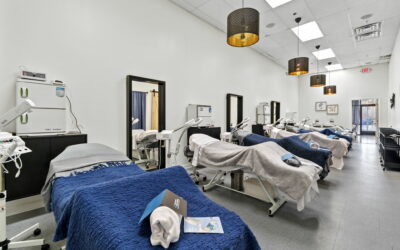
Reasons for Undergoing a Chemical Peel
A chemical peel is a procedure that helps to resurface the skin. Depending on the specific concerns being addressed, there are three different depths of chemical peels to choose from:
- Light chemical peel: This type of peel removes the outer layer of skin, known as the epidermis. It treats fine wrinkles, acne, uneven skin tone, and dryness. Light peels can be done every two to five weeks.
- Medium chemical peel: A medium peel removes skin cells from the epidermis and the upper part of the middle layer of skin, known as the dermis. It treats wrinkles, acne scars, and uneven skin tone. Multiple treatments may be necessary to achieve the desired results.
- Deep chemical peel: A deep peel removes skin cells even deeper. It is recommended for deeper wrinkles, scars, or precancerous growths. Unlike the other peels, a deep peel does not require repeat procedures to achieve the desired effect.
It is important to note that chemical peels cannot remove deep scars or wrinkles, nor can they tighten sagging skin.
Potential Risks
There are several potential side effects and risks associated with chemical peels, including:
Redness, scabbing, and swelling
It is normal for the treated skin to appear red during the healing process. After a medium or deep peel, redness may last for several months.
Scarring
Although rare, scarring can occur due to a chemical peel. Antibiotics and steroid medications can be used to minimize the appearance of these scars.
Changes in skin color
A chemical peel can cause the treated skin to become darker (hyperpigmentation) or lighter (hypopigmentation) than usual. Hyperpigmentation is more common after superficial peels, while hypopigmentation is more common after deep peels. These issues are more prevalent in individuals with brown or black skin and may sometimes be permanent.
Infection
There is a risk of bacterial, fungal, or viral infection following a chemical peel, which can include flare-ups of the herpes virus, which causes cold sores.
Heart, kidney, or liver damage
Deep chemical peels that use carbolic acid (phenol) can potentially damage the heart, kidneys, and liver. Deep peels are typically done in intervals of 10 to 20 minutes to minimize exposure to phenol.
It is essential to consult with a doctor before undergoing a chemical peel, as individuals should determine if they are suitable candidates.
High-risk individuals include those who have taken oral acne medication isotretinoin in the past six months, individuals with a history of keloids, pregnant women, and those who experience frequent or severe cold sore outbreaks.
Preparation
When preparing for a chemical peel, it is crucial to choose a doctor who is knowledgeable about the procedure and has expertise in dermatology or dermatologic surgery. The results of the peel can vary depending on the skill of the person performing it, and complications such as infection and scarring can occur if it is not done correctly.
Before undergoing a chemical peel, the doctor will typically:
Review your medical history
This includes discussing current or past medical conditions, medications, and cosmetic procedures.
Conduct a physical exam
The doctor will examine your skin and the area to be treated to determine the most suitable type of peel and how your physical features may affect the results.
Discuss expectations
It is essential to talk with the doctor about your motivations, expectations, and potential risks, which will help ensure you understand the number of treatments required, the healing time, and the possible outcomes.
In preparation for the peel, you may need to:
- Antiviral medication may be prescribed to prevent viral infections before and after the treatment.
- Use a retinoid cream: Your doctor may recommend using a retinoid cream for a few weeks before the treatment to aid healing.
- Use a bleaching agent: To reduce the risk of side effects, your doctor may suggest using a bleaching agent or a combination of a bleaching agent and retinoid cream before or after the procedure.
- Avoid sun exposure: Excessive exposure before the procedure can cause irregular pigmentation in the treated areas. Discussing sun protection and acceptable sun exposure with your doctor is fundamental.
- Avoid specific cosmetic treatments and hair removal: About a week before the peel, it is advised to stop using hair removal techniques, hair dye treatments, facial masks, or facial scrubs. Shaving the treated areas should also be avoided 24 hours before the peel.
Additionally, arranging a ride home is necessary if sedation is required during the procedure.
Procedure Expectations
A chemical peel is typically performed in a doctor’s office or outpatient surgical facility. Before the procedure, your doctor will clean your face, protect your hair, and cover your eyes with ointment, gauze, tape, or goggles.
Pain relief is usually not necessary for a light chemical peel. However, a sedative and painkiller may be administered for a medium peel. A deep peel may require a sedative, numbing of the treatment area, and intravenous fluids.
During the procedure:
Light chemical peel
A chemical solution containing glycolic acid or salicylic acid is applied to the skin using a brush, cotton ball, gauze, or sponge. The treated skin will whiten, and mild stinging may be felt. A neutralizing solution or wash is then applied to remove the chemical solution.
Medium chemical peel
A chemical solution containing trichloroacetic acid, sometimes combined with glycolic acid, is applied to the skin using a cotton-tipped applicator or gauze. The treated skin will whiten; after a few minutes, cool compresses are applied to soothe the skin. No neutralizing solution is needed.
Deep chemical peel
A cotton-tipped applicator applies carbolic acid (phenol) to the skin. The treated skin will turn white or gray. The procedure is done in intervals of about 15 minutes to limit exposure to phenol. A full facial procedure may take around 90 minutes.
After the Procedure
Following a chemical peel of any depth, the skin may appear red, tight, irritated, or swollen. Following the doctor’s instructions regarding sun protection, cleansing, moisturizing, and applying protective ointments to the skin is integral. Avoid picking, rubbing, or scratching the skin. It may take several months for the skin color to return to normal and for the full results of the peel to be visible.
Light Chemical Peel
After a light chemical peel, the treated skin may be red, dry, and mildly irritated. These effects may become less noticeable with each repeat treatment. A protective ointment, such as petroleum jelly, may be applied by the doctor to soothe the skin. Makeup can usually be worn the day after the peel.
Treated areas typically take one to seven days to heal after a light chemical peel. The new skin may temporarily appear lighter or darker than usual.
Medium Chemical Peel
Following a medium chemical peel, the treated skin will exhibit signs of redness and swelling. You may experience a stinging sensation as well. Your doctor may apply a protective ointment like petroleum jelly to alleviate these symptoms and prevent dryness. After five to seven days, you can use cosmetics to cover up any remaining redness.
For comfort, you can use ice packs. Over-the-counter pain-relieving medication such as ibuprofen or naproxen sodium can help reduce any discomfort. You will likely schedule a follow-up appointment with your doctor to monitor the healing process.
As the swelling subsides, the treated skin will form a crust and may darken or develop brown blotches. The treated areas typically take about seven to 14 days to heal after a medium chemical peel fully, but redness may persist for several months.
Deep Chemical Peel
In the case of a deep chemical peel, you will experience severe redness and swelling. The burning and throbbing sensation may be intense, and the swelling could cause your eyelids to swell shut.
Your doctor will apply a surgical dressing to the treated skin and may prescribe painkillers. You must soak the treated skin and apply ointment multiple times daily for approximately two weeks.
New skin will develop within about two weeks after a deep chemical peel, although redness may persist for several months. The treated skin may become darker or lighter than normal and lose its tanning ability.
During the healing process, it may be preferable to stay at home. You will likely have several follow-up visits with your doctor to ensure proper healing.
Once the new skin completely covers the treated area in about two weeks, you can use cosmetics to conceal any remaining redness. It is paramount to use sunscreen daily.
Results
- A light chemical peel improves skin texture and tone while reducing the appearance of fine wrinkles. The results are subtle but become more noticeable with repeated treatments.
- A medium chemical peel will noticeably enhance the smoothness of the treated skin.
- After a deep chemical peel, you will witness a significant improvement in the appearance and texture of the treated areas.
Please note that the results may be temporary. Over time, aging and new sun damage can lead to the development of new lines and changes in skin color.
Regardless of the type of peel, the newly treated skin will be more sensitive to the sun temporarily. It is crucial to consult with your doctor regarding the duration of sun protection for your skin.
Resources & News
The Artistry of Aesthetic Injectors
In the realm of aesthetic enhancement, the role of injectors transcends...
Esthetician vs. Aesthetician
What's the difference from an esthetician and an aesthetitican? Are you...
Overview of Our Esthetic Program
The NoVa Esthetics Training School's esthetics program is a comprehensive...






